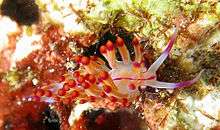Coryphellina rubrolineata
Coryphellina rubrolineata is a species of sea slug, an aeolid nudibranch, a marine heterobranch mollusc in the family Flabellinidae.[2]
| Coryphellina rubrolineata | |
|---|---|
 | |
| Scientific classification | |
| Kingdom: | |
| Phylum: | |
| Class: | |
| Subclass: | |
| Superfamily: | |
| Family: | |
| Genus: | |
| Species: | C. rubrolineata |
| Binomial name | |
| Coryphellina rubrolineata O'Donoghue, 1929[1] | |
| Synonyms | |
| |
Description
Coryphellina rubrolineata is a relatively large aeolid nudibranch growing to 42 mm in length.[3] The stretched out body has a sharp end at the tail, the dorsal side is covered with a certain amount of extensions called cerata, which size vary from an animal to another. The rhinophores are pointed and look like feathers. The oral tentacles are thin, cylindrical and longer than the rhinophores.[4] The coloration is variable and here's a description for the two main coloration which can be easily met underwater:
- The classic coloration: the body is milky white to translucent, three reddish to purple continuous or dotted lines are running on both side and in the middle of the body, oral tentacles and rhinophores are whitish with a mauve to purple ring at the two third of their extremity, cerata are also whitish with a purple ring and with orange tip.
- The purple coloration: whole body including cerata, rhinophores and oral tentacles are purple to mauve, without any continuous reddish line on the body but with just a darker ring at the two third of the cerata with clearest tips.
Many colour variations exist and it is likely that this species is really a species complex.[5]
Distribution & habitat
This species was described from the Red Sea. Coryphellina rubrolineata is thought to be widespread in tropical, subtropical and temperate waters in the Indo-Pacific area and also as a migrant species in the Mediterranean Sea. [6] It is also commonly observed on shallow reef or rocky slopes rich in hydroids which represent its main diet.[7]
Biology
Like mainly all aeolids, Coryphellina rubrolineata has the ability to store the stinging cells from cnidarians eaten. This stinging cells stock is a particularly effective means of defense and is located at the ends of cerata, it is contained in cnidosacs.[7]
References
- O'Donoghue, C. H. 1929. XXXVIII. Report on the Opisthobranchia. In: Zoological results of the Cambridge Expedition to the Suez Canal, 1924. Transactions of the Zoological Society of London 22(6):713-841.
- Gofas, S. (2015). Flabellina rubrolineata (O'Donoghue, 1929). In: MolluscaBase (2015). Accessed through: World Register of Marine Species on 2015-10-25
- Bidgrain, P. 2015. Flabellina rubrolineata (O'Donoghue, 1929). At seaslugs.free.fr, retrieved 2015-11-07.
- Cory Pittman and Pauline Fiene Flabellina rubrolineata Sea slugs of Hawaii.
- Rudman, W.B., 1998 (January 9) Flabellina rubrolineata (O'Donoghue, 1929). [In] Sea Slug Forum. Australian Museum, Sydney.
- Gosliner, T. M., & Richard C. Willan. 1991. Review of the Flabellinidae (Nudibranchia: Aeolidacea) from the tropical Indo-Pacific, with the descriptions of five new species. Veliger 34(2):97-133. page 114
- Le Bris, S., Sutour, J.-M., in : DORIS, 29/3/2014 : Flabellina rubrolineata (O'Donoghue, 1929).
External links
- Photos of Coryphellina rubrolineata on Sealife Collection